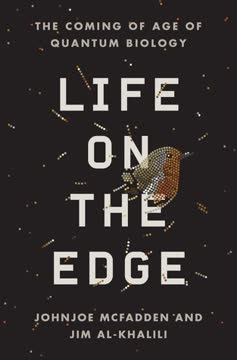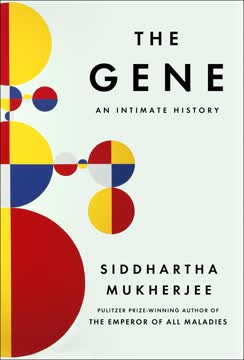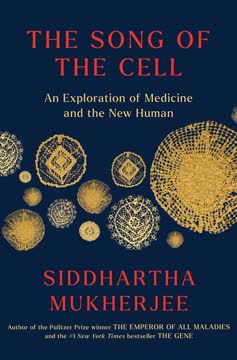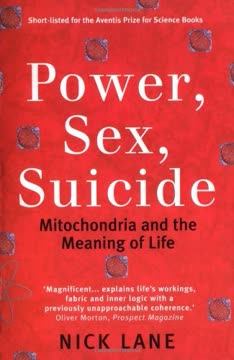Key Takeaways
1. Mitochondria: The Powerhouses and Puppeteers of Complex Life
Mitochondria are a badly kept secret. Many people have heard of them for one reason or another.
Multifaceted organelles. Mitochondria are tiny organelles inside cells that generate almost all our energy in the form of ATP. On average, there are 300-400 in every cell, totaling ten million billion in the human body. Essentially all complex cells contain mitochondria.
Ancient bacterial origins. Mitochondria look like bacteria, and appearances are not deceptive: they were once free-living bacteria that adapted to life inside larger cells about two billion years ago. They retain a fragment of a genome as a badge of former independence.
Shapers of life's complexity. Their tortuous relations with their host cells have shaped the whole fabric of life, including:
- Energy production
- Sexual reproduction
- Fertility
- Cell suicide (apoptosis)
- Aging
- Death
2. The Evolutionary Chasm Between Bacteria and Eukaryotes
The void between bacterial and eukaryotic cells is greater than any other in biology.
Bacteria's limitations. Bacteria have dominated the world for two billion years, colonizing all thinkable environments. However, they never evolved into the kind of multicellular organism that a layperson might recognize. Their complexity is curtailed by their need to generate energy across the outer cell membrane.
Eukaryotic leap. The eukaryotic cell appeared much later and, in a fraction of the time available to bacteria, gave rise to the great fountain of life we see around us. This includes:
- Elaborate internal membrane systems
- Specialized organelles
- Complex cell cycles
- Sexual reproduction
- Huge genomes
- Phagocytosis
- Predatory behavior
- Multicellularity
- Large size
- Spectacular feats of mechanical engineering (e.g., flight, sight, hearing)
One-time event. The evolution of the eukaryotic cell was likely a one-time event, bridging the gulf between bacteria and complex life through endosymbiosis.
3. The Hydrogen Hypothesis: A Radical Origin Story
A mutual chemical dependency between two very different prokaryotic cells led to a close relationship between the two.
Symbiotic origin. The hydrogen hypothesis proposes that the eukaryotic cell originated from a symbiotic relationship between two prokaryotes:
- A methanogen (archaeon) host
- A hydrogen-producing alpha-proteobacterium (ancestor of mitochondria)
Metabolic interdependence. The methanogen used hydrogen produced by the bacterium, while the bacterium benefited from the methanogen's metabolic by-products. This mutual dependency led to their physical merger.
Gene transfer and transformation. Over time, genes transferred from the endosymbiont to the host, enabling the host to:
- Import organic molecules
- Ferment them in the cytoplasm
- Pass fermentation products to the proto-mitochondria for further processing
This gene transfer and metabolic reorganization transformed the symbiotic relationship into the first eukaryotic cell, capable of thriving in diverse environments.
4. Proton Power: The Universal Energy Currency of Life
Not since Darwin has biology come up with an idea as counterintuitive as those of, say, Einstein, Heisenberg or Schrödinger.
Chemiosmotic theory. Peter Mitchell's chemiosmotic theory revolutionized our understanding of cellular energy production. The key points are:
- Energy is stored as a proton gradient across membranes
- This gradient drives ATP synthesis
- The process is universal across all domains of life
Proton-motive force. The proton gradient creates a proton-motive force, which:
- Has the power of a bolt of lightning over a few nanometers
- Drives ATP synthesis through the ATPase (a molecular motor)
- Powers various cellular processes beyond ATP production
Implications for life's origin. This mechanism is so fundamental that it provides insights into the origin of life itself:
- It's found in all forms of life, including the most primitive bacteria
- It may have evolved in alkaline hydrothermal vents
- It could explain why life is chemiosmotic and why it originated on Earth
5. Why Bacteria Remained Simple: The Geometric Constraint
Bacteria are limited in their physical size, genome content, and complexity, they say, because they are forced to respire across their external cell membrane.
Surface area to volume ratio. As bacteria grow larger:
- Their surface area increases more slowly than their volume
- This reduces their energetic efficiency
- Larger bacteria are less competitive than smaller ones
Energetic limitations. The reliance on the outer membrane for energy generation means:
- Bacteria can't grow too large without losing efficiency
- This precludes the evolution of complex, energy-intensive behaviors like phagocytosis
- It limits the genome size and complexity bacteria can support
Evolutionary pressure. These constraints create a strong evolutionary pressure for bacteria to:
- Remain small
- Maintain a streamlined genome
- Quickly lose any genes that aren't immediately beneficial
This explains why bacteria, despite their biochemical diversity, have remained morphologically simple for billions of years.
6. Mitochondria Enable Complexity Through Energy Internalization
Internalization of energy generation within the cell means that an external cell wall is no longer needed, and so can be lost without inducing fragility.
Breaking the size barrier. Mitochondria allow eukaryotic cells to be much larger than bacteria:
- They generate energy inside the cell, not across the outer membrane
- This frees cells from the surface area to volume constraint
- Eukaryotes can be 10,000 to 100,000 times the volume of bacteria
Enabling new lifestyles. The internalization of energy production:
- Allows the loss of the rigid cell wall
- Enables the cell membrane to specialize in other tasks (signaling, movement)
- Makes phagocytosis possible, allowing predatory lifestyles
Scaling up energy production. As eukaryotic cells grow larger:
- They can maintain energy balance by keeping more mitochondria inside
- This allows for the evolution of larger, more complex organisms
- It provides the energy needed for sophisticated behaviors and structures
7. The Power Laws of Biology: Size, Metabolism, and Complexity
Metabolic rate is defined as the consumption of oxygen and nutrients. If the metabolic rate falls, then each cell consumes less food and oxygen.
Kleiber's Law. As animals increase in size:
- Their metabolic rate increases more slowly than their mass
- This relationship follows a power law: metabolic rate scales with mass^0.75
- This means larger animals are more energetically efficient per unit of mass
Implications for evolution. This scaling law has profound effects on:
- Population density
- Range of travel distances
- Number of offspring
- Time to reproductive maturity
- Speed of population turnover
- Rate of evolution
Debated universal constant. While the exact exponent (0.75) is debated, the general principle holds across a wide range of organisms:
- From single cells to blue whales
- Spanning 21 orders of magnitude in mass
- Applying to various biological traits beyond metabolism
This scaling law provides insights into the evolution of size and complexity in living organisms.
8. Warm-Bloodedness: A Mitochondrial Revolution
If the resting metabolic rate scales with an exponent of less than 1 (it doesn't matter what the precise value is) implies that the energetic demand of cells falls with size—larger organisms do not need to spend as great a proportion of their resources on the business of staying alive.
Aerobic capacity hypothesis. The evolution of warm-bloodedness (endothermy) in mammals and birds was likely driven by:
- Selection for greater aerobic capacity (speed and endurance)
- A linked increase in resting metabolic rate
Mitochondrial density. Endothermy is associated with:
- Higher mitochondrial density in muscles and organs
- Greater aerobic performance (up to 10 times that of similarly sized ectotherms)
- Ability to sustain high levels of activity
Evolutionary trade-offs. The benefits of endothermy come at a cost:
- Mammals use about 30 times more energy than equivalent reptiles
- This requires much higher food intake
- It enables new ecological niches and behaviors, but at a high energetic cost
The evolution of endothermy represents a major metabolic shift, enabled by mitochondria, that opened up new evolutionary possibilities for complex life.
9. Apoptosis: Mitochondria as Arbiters of Cellular Life and Death
If, today, we still succumb to the lawlessness of cancer, what hope had the first individuals?
Mitochondrial control. Mitochondria play a central role in apoptosis (programmed cell death):
- They integrate various cellular signals
- They decide whether a cell should live or die
- If death is warranted, they release proteins that activate the cell's death machinery
Evolutionary origins. The machinery of apoptosis has bacterial origins:
- Most apoptotic proteins were brought by the ancestors of mitochondria
- This suggests apoptosis evolved from conflict between early endosymbionts and their hosts
From sex to death. The apoptotic machinery may have originally evolved to promote sex in single-celled eukaryotes:
- Mitochondria could signal host cell damage through free radical production
- This could stimulate cell fusion and genetic recombination
- Over time, this machinery was co-opted for programmed cell death in multicellular organisms
10. The Troubled Birth of Multicellular Individuals
Cancer can persist because it is rare in younger individuals: if the body were to tear itself asunder by internal squabbles before the community of cells had engineered their own reproduction, though the germ-line, then the individual as a whole would fail to pass on its genes, and the selfish genes would be lost from the population.
Cellular cooperation and conflict. The evolution of multicellularity required:
- Cells to subordinate their selfish interests to the whole
- Mechanisms to suppress cellular rebellion (cancer)
- The evolution of programmed cell death (apoptosis)
Apoptosis as cellular police. Programmed cell death serves to:
- Eliminate damaged or potentially harmful cells
- Maintain the integrity of the multicellular individual
- Balance cell division to regulate tissue size and function
From single cells to complex organisms. The transition to multicellularity involved:
- Resolving conflicts between different levels of organization (genes, organelles, cells)
- Evolving new regulatory mechanisms to coordinate cellular behavior
- Harnessing mitochondrial-derived apoptosis for the greater good of the organism
This troubled birth of multicellular individuals set the stage for the evolution of complex life forms, including ourselves.
Last updated:
FAQ
What's Power, Sex, Suicide: Mitochondria and the Meaning of Life about?
- Exploration of Mitochondria: The book delves into the role of mitochondria, the organelles responsible for energy production in cells, and their influence on biological processes like sex, aging, and life's meaning.
- Evolutionary History: It discusses the evolutionary journey from simple prokaryotic cells to complex eukaryotic organisms, highlighting the pivotal merger between a bacterium and an archaeon.
- Interconnected Themes: The narrative connects energy production, the origin of life, and the evolution of complexity, suggesting that understanding mitochondria is key to understanding life itself.
Why should I read Power, Sex, Suicide by Nick Lane?
- Unique Insights: The book offers a fresh perspective on biology by focusing on often-overlooked mitochondria, challenging conventional views and encouraging readers to rethink life's foundations.
- Engaging Writing Style: Nick Lane's accessible and engaging writing makes complex scientific concepts understandable, weaving storytelling with scientific inquiry.
- Implications for Humanity: It raises profound questions about existence, aging, and life's nature, making it relevant to anyone interested in biology, philosophy, or the human condition.
What are the key takeaways of Power, Sex, Suicide?
- Mitochondria's Central Role: Mitochondria are crucial for energy production and processes like apoptosis and aging, maintaining cellular health and function.
- Unique Evolutionary Event: The evolution of eukaryotic cells was a unique event driven by a bacterium-archaeon merger, essential for complex life forms.
- Energy and Complexity: The internalization of energy generation in mitochondria allowed for greater complexity in eukaryotic organisms compared to bacteria.
How do mitochondria influence sex and gender according to Power, Sex, Suicide?
- Asymmetry of Sex: The book links the existence of two sexes to mitochondria's role in reproduction, with females specializing in passing on mitochondria.
- Mitochondrial Eve: It introduces "Mitochondrial Eve," the most recent common ancestor of all living humans traced through maternal lineage, highlighting mitochondrial DNA's importance in human ancestry.
- Gender Roles: The biological differences in mitochondrial inheritance may have influenced social structures and gender roles throughout history.
What is the Mitochondrial Theory of Aging presented in Power, Sex, Suicide?
- Free Radical Damage: Aging is caused by damage from reactive molecules called free radicals, which leak from mitochondria during respiration, leading to cellular dysfunction.
- Mitochondrial Mutations: Mutations in mitochondrial DNA can lead to degenerative diseases, particularly affecting metabolically active tissues like muscles and the brain.
- Potential for Cures: The book explores targeting mitochondria for therapeutic interventions to combat aging and related diseases, opening new research avenues.
What is the Hydrogen Hypothesis in Power, Sex, Suicide?
- Origin of Eukaryotic Cells: The hypothesis posits that eukaryotic cells arose from a symbiotic relationship between a methanogen and a versatile -proteobacterium, allowing for internalized energy production.
- Chemical Dependency: The mutual dependency between these cells was crucial for complex life evolution, with the methanogen providing stability and the -proteobacterium contributing energy.
- Evolutionary Significance: This challenges traditional views, suggesting the merger was a unique event paving the way for complex life forms, emphasizing symbiosis in evolution.
How does Power, Sex, Suicide connect to the origin of life?
- Chemiosmotic Mechanism: The energy generation mechanism in mitochondria, chemiosmosis, is fundamental to understanding life's origin, possibly present in early life forms.
- Inorganic Membranes: Early life may have used inorganic membranes, like iron-sulphur minerals, to create the first cells, linking life's origins to energy generation principles.
- Proton Gradients: Proton gradients as an energy source are central to both life's origin and modern cells' functioning, suggesting deep evolutionary roots.
What are the implications of mitochondrial research for understanding evolution in Power, Sex, Suicide?
- Evolutionary Significance: Mitochondria have been crucial in complex life evolution, influencing energy production and sexual reproduction.
- Sexual Selection: Mitochondrial dynamics may have influenced sexual reproduction evolution and the development of two sexes.
- Adaptation and Survival: Mitochondrial function affects an organism's adaptability to environmental changes, impacting survival and reproductive success.
How does Power, Sex, Suicide address the concept of free radicals?
- Dual Role of Free Radicals: Free radicals are both harmful and beneficial, serving as signals for cellular processes.
- Impact on Aging and Disease: They contribute to aging and diseases through mitochondrial dysfunction.
- Signaling Mechanisms: Free radicals help regulate mitochondrial function and cellular health, influencing processes like apoptosis.
What are the broader implications of Power, Sex, Suicide for understanding life on Earth?
- Interconnectedness of Life: The book emphasizes interconnected biological processes, from energy production to reproduction and aging.
- Evolutionary Biology: Lane's arguments challenge traditional evolution views, suggesting symbiosis and unique cell mergers played crucial roles in complex life development.
- Future Research Directions: Insights open new research avenues in regenerative medicine, cancer biology, and evolutionary studies, highlighting mitochondria's importance in health and disease.
What are the best quotes from Power, Sex, Suicide and what do they mean?
- “Mitochondria are the clandestine rulers of the world.”: Highlights mitochondria's hidden yet powerful role in biology, influencing aging and reproduction.
- “The origin of the eukaryotic cell was a unique event that happened only once.”: Emphasizes the rarity and significance of the merger leading to complex cells.
- “Without mitochondria, complex life is simply not possible.”: Reinforces mitochondria's essential role in evolving complexity in organisms.
How does Power, Sex, Suicide connect mitochondria to health and disease?
- Link to Chronic Diseases: Mitochondrial dysfunction is implicated in chronic diseases like diabetes and heart disease.
- Role in Aging: Declining mitochondrial function with age increases age-related disease risk.
- Potential for Therapeutic Interventions: Enhancing mitochondrial function could lead to better health outcomes, suggesting a path for future research.
Review Summary
Power, Sex, Suicide is a dense but fascinating exploration of mitochondria's role in evolution and life. Lane argues that mitochondria are crucial for complex life, responsible for sex, cell death, and aging. While challenging for non-scientists, readers praise Lane's clear explanations and engaging style. The book covers topics like energy production, free radicals, and theories on life's origins. Some criticize Lane's assertiveness, but most find the book informative and thought-provoking. It's recommended for those interested in biology and evolution, offering a comprehensive look at mitochondria's significance in life's processes.
Similar Books









Download PDF
Download EPUB
.epub digital book format is ideal for reading ebooks on phones, tablets, and e-readers.







